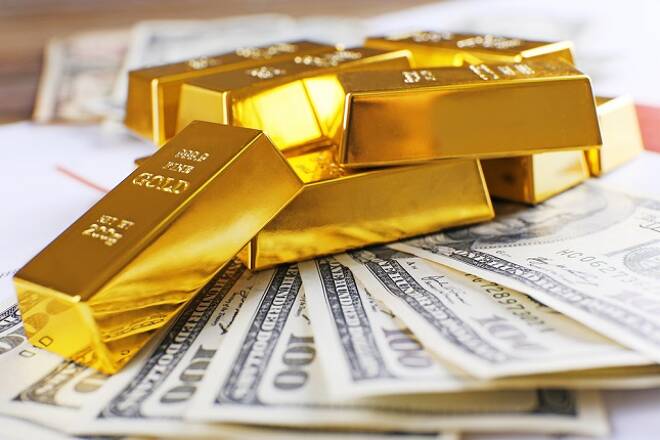Advertisement
Advertisement
A Fair Price For Gold – $1000 Or $2000?
By:
Gold (or any other money) is worth what we can buy with it. So, what can we buy with it? And how do we know that the value of our gold/money is realistically priced?
We know that gold is currently priced at more than $1800 per ounce; so the value of gold today is what we can buy with one thousand eight hundred dollars.
But is $1800 dollars per ounce realistic? Does it represent fair value? Are there reasons why we might expect that price to rise or decline to any substantial degree that would influence our choice to hold money in gold vs. US dollars?
Let’s go back to a time when both gold and the US dollar circulated as money, were freely convertible, and were equal in value.
A century ago, both gold and US dollars were legal tender, and interchangeable. Either was convertible into the other at a fixed price. A one ounce (.97 ounces) gold coin was equal to twenty US Dollars and vice-versa (the official gold price was $20.67 per ounce, which multiplied by .97 ounce of gold in a gold coin equals $20.00).
With the current price of gold at $1800, some would be tempted to say that the value of gold over the past one hundred years has increased by eighty-six hundred percent. But that would mean that one ounce of gold today will buy eighty seven times as much as it would a hundred years ago. We know that is not the case.
The specifics are two-fold: 1) Gold gained in price by eight-six hundred percent relative to the US dollar. 2) The US dollar declined by more than ninety-eight percent relative to gold.
GOLD AND US DOLLAR PURCHASING POWER
Now we need to know how both gold and the U.S. dollar fared in absolute terms regarding purchasing power. You can read about that in my article A Loaf Of Bread, A Gallon Of Gas, An Ounce Of Gold
The results are clear. Gold has maintained its value, and even increased its purchasing power in absolute terms, over the century-long period under consideration.
What we don’t know is the extent to which the current price of $1800 per ounce reflects accurately the effects of inflation that have occurred to this point. More specifically, how much purchasing power has the US dollar lost? Is it ninety-eight percent or less; ninety-nine percent or more?
A gold price at $1800 indicates a specific loss of 98.8% in US dollar purchasing power. A ninety-nine percent decline in the value of the US dollar translates to a gold price of over $2000 per ounce. If the decline is closer to ninety-eight percent, then the gold price should be closer to $1,000 per ounce.
In August 2011, gold peaked at almost $1900.00 per ounce. That indicates a loss in purchasing power of the U.S. dollar close to ninety-nine percent (98.9%).
Nearly four and one-half years later, in January 2016, gold traded as low as $1040.00 per ounce. That price indicates a decline in U.S. dollar purchasing power closer to ninety-eight percent. A ninety-eight percent decline in U.S. dollar value equates to a fifty fold increase in the gold price (100 percent minus 98 percent = 2 percent; 100 percent divided by 2 percent = 50; $20.67 per ounce times 50 = $1033.50 per ounce).
Last August (2020) the gold price peaked at $2060. That indicates a loss in purchasing power of the U.S. dollar at ninety-nine percent, which translates to a one-hundred fold increase in the gold price (100 percent minus 99 percent = 1 percent; 100 percent divided by 1 percent = 100; $20.67 per ounce times 100 = $2067.00 per ounce).
CONCLUSIONS:
- The US dollar has lost between ninety-eight and ninety-nine percent of its purchasing power over the past century.
- Gold is realistically priced at anywhere between $1000 and $2000 per ounce.
- Further increases in gold’s price will come only after further actual and apparent losses in US dollar purchasing power.
Expectations for further deterioration in the US dollar will not lead to further increases in gold’s price. That is because the price of gold in dollars represents the actual loss in purchasing power that has already occurred.
In other words, gold is approaching its upper boundary ($2060)) based on actual accrued losses in US dollar purchasing power (99%).
Items for consideration that could have a substantial impact on the US dollar include 1) new and unexpected actions by the Federal Reserve; 2) a clearer picture of the enormity of the Fed’s balance sheet; 3) accelerated, delayed effects of inflation previously created by the Fed; 4) a credit implosion; 5) Fed’s reaction to a credit implosion; 6) Deflation and Depression.
Some items above can affect the value of the US dollar positively, which is why you need to keep your eye on the dollar, and not the specific event.
Kelsey Williams is the author of two books: INFLATION, WHAT IT IS, WHAT IT ISN’T, AND WHO’S RESPONSIBLE FOR IT and ALL HAIL THE FED!
About the Author
Kelsey Williamscontributor
Kelsey Williams has more than forty years experience in the financial services industry, including fourteen years as a full-service financial planner.
Did you find this article useful?
Latest news and analysis
Advertisement
